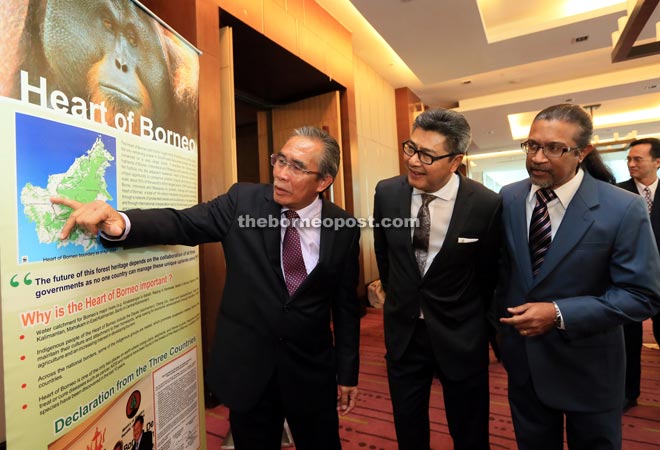
Len (left) pointing on a spot in the HoB map while Sudarsono (second left) and WWF-Malaysia chief executive officer Datuk Dr Dino Sharma look on.
KUCHING: The state government will expand and establish new Totally Protected Areas (TPA) within the Heart of Borneo (HoB) in Sarawak, with plans for effective management and increasing the size of protected areas as well as enhancing their connectivity.
Chief Minister Datuk Patinggi Tan Sri Adenan Satem said this would help to preserve their ecological integrity, enhance the flow of ecosystem services and facilitate gene flow and build resilience in a changing climate.
“Many more national parks, both gazetted as well as proposed, would now be connected to each other,” he said in his speech read out by Assistant Minister of Environment Datu Len Talif Salleh at the launching of International Workshop on Heart of Borneo Corridor Project Implementation at a hotel, here, yesterday.
The HoB initiative is a voluntary trans-boundary cooperation between three countries – Brunei, Indonesia and Malaysia – combining the stakeholders’ interests, based on local wisdom, acknowledgment of and respect for laws, regulations and policies of the respective countries.
Adenan said Sarawak’s cooperation is based on sustainable development principles through research and development, sustainable use, protection, education and training, fundraising, as well as other activities relevant to trans-boundary management, conservation and development within the areas of HoB.
According to him, the state’s contributions to the HoB initiative would be its policy on sustainable forest management, nature conservation through the establishment of TPAs and Trans-Boundary Conservation Areas (TBCAs), as well as planning and development of new socio-economic projects to benefit the rural populations, all of which would contribute to conservation and sustainable development.
“We have engaged WWF-Malaysia to implement strategic conservation plan for Sarawak. Under this project, we will identify areas for conservation that include as much biodiversity where possible, across a full range of variation of species, habitats or ecological processes that are adequate for the existence of biodiversity features and achieving these conservation objectives at minimal costs.”
He said the state government had called on timber concession holders within the HoB to obtain forest management certification by 2017, adding that forest certification is in line with Sarawak’s commitment to sustainable forest management.
“Forest management certification is a confirmation of compliance of forest management practices within agreed set of rules expressed in the form of Principles Criteria, Indicators and Management Specifications.
“Ultimately, this means that Sarawak is not only committing to protection of valuable nature but the areas surrounding these national parks will be managed in such a way that they will be supportive of the protection of vital ecosystem services and therefore will be beneficial both economically as well as environmentally for generations to come.
“We hope the expansion of the totally protected area and the sustainable land use in the HoB area will create connectivity between the landscapes and a corridor for our wildlife.”
Adenan said Sarawak had been working with Indonesia (Kalimantan) on two important trans-boundary biodiversity conservation projects funded by International Tropical Timber Organization (ITTO) in the Lanjak Entimau Wildlife Sanctuary/Betung Kerihun National Park and Pulong Tau National Park/Kayan Mentarang National Park areas.
To further enhance trans-boundary conservation, the state government hoped to have a trans-boundary conservation area between Brunei and Sabah.
“The state government is very serious about conserving the natural resources and prepared to work with international bodies and local communities as well as sponsoring studies on ways to retain biological biodiversity.
“The state government is willing to work with any NGO (non-governmental organisation) if their agenda is truly on conservation and sustainable management of Sarawak forest.”
